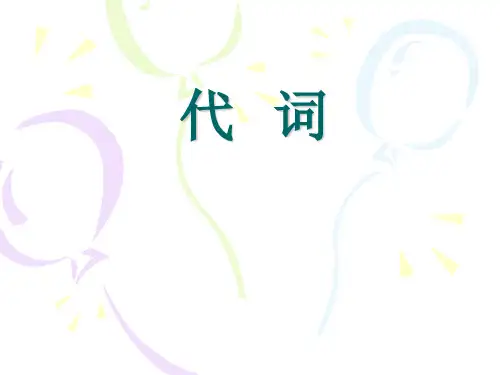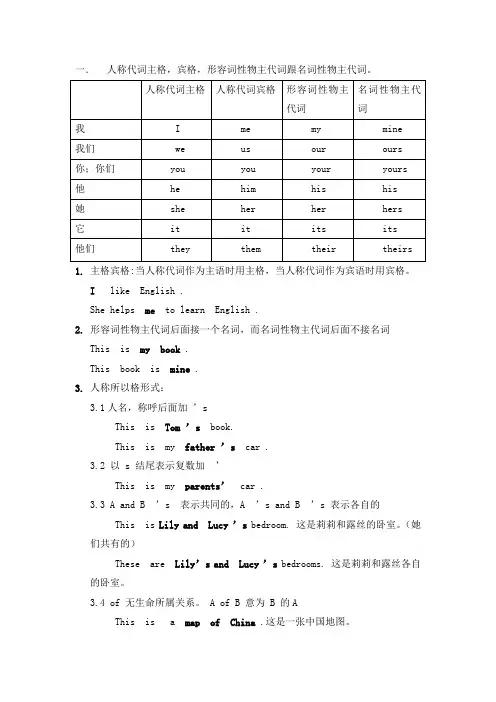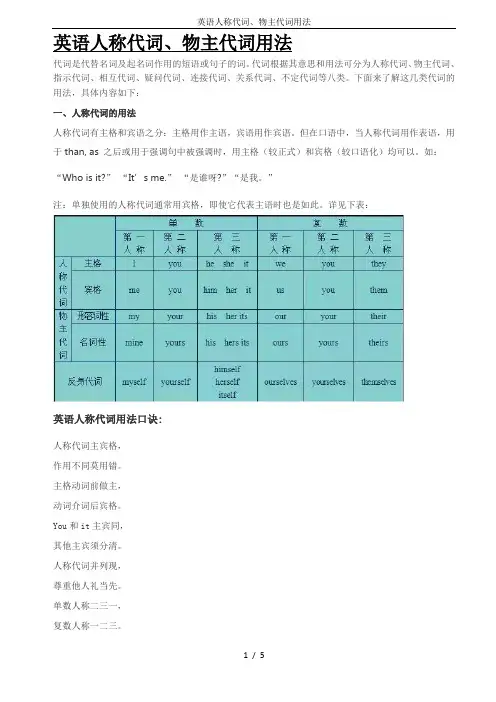主格和宾格以及物主代词的用法
- 格式:doc
- 大小:38.50 KB
- 文档页数:2

1、人称代词顺口溜:人称代词有两类,一类主格一类宾;主格代词本领大,一切动作由它发;宾格代词不动脑,介动之后跟着跑。
2、物主代词顺口溜:物主代词不示弱,带着‘白勺’来捣乱;形容词性物主代,抓住名词不放松;最后只剩名词性,海阔天空任它走.人称代词的用法1、人称代词的主格在句子中作主语或主语补语。
一般在句首,动词前.例如:John waited a while but eventually he went home.约翰等了一会儿,最后他回家了。
John hoped the passenger would be Mary and indeed it was she。
约翰希望那位乘客是玛丽,还真是她。
说明:在复合句中,如果主句和从句主语相同,代词主语要用在从句中,名词主语用在主句中。
在电话用语中常用主格.例如:When he arrived,John went straight to the bank。
约翰一到就直接去银行了。
I wish to speak to Mary. This is she。
我想和玛丽通话,我就是玛丽。
2、人称代词的宾格在句中作宾语或表语,在动词或介词后。
例如:Do you know him?(作宾语) 你认识他吗?Who is knocking at the door?It’s me. (作表语)是谁在敲门?是我。
说明:单独使用的人称代词通常用宾格,即使它代表主语时也是如此。
例如:I like English。
Me too。
我喜欢英语.我也喜欢。
3、注意:在动词be 或to be 后的人称代词视其前面的名词或代词而定。
例如:I thought it was she.我以为是她。
(主格—---主格)I thought it to be her。
(宾格---—宾格)I was taken to be she。
我被当成了她.(主格————主格)They took me to be her.他们把我当成了她.(宾格———-宾格)4、人称代词并列时的排列顺序1)单数人称代词并列作主语时,其顺序为:第二人称→第三人称→第一人称即you and I he/she/it and I you, he/she/it and I顺口溜:第一人称最谦虚,但若错误责任担,第一人称学当先.例如:It was I and John that made her angry。

人称代词和物主代词的用法区别一、什么是人称代词和物主代词二、人称代词的用法1. 主格形式的人称代词2. 宾格形式的人称代词3. 形容词性物主代词与名词性物主代词三、物主代词的用法1. 形容词性物主代词2. 名词性物主代词四、两者之间的区别和使用注意事项一、什么是人称代词和物主代词在语法中,人称代词指的是替换特定名字或名称,用于表示说话者、听话者或与他们相关联的人。
而物主代词则表示所属关系,指示某物由某个特定个体拥有或控制。
二、人称代词的用法1. 主格形式的人称代词主格形式的人称代词常出现在句子中作为主语,并与动作发生者相对应。
例如:- I like to read.- You are my best friend.2. 宾格形式的人称代词宾格形式的人称代词通常出现在句子中作为动作接受者,并且总是由及物动词或介系动入引导的短语所跟随。
例如:- She called me this morning.- They invited us to the party.3. 形容词性物主代词与名词性物主代词形容词性物主代词用来描述或限定名词,是名词的形容词修饰成分,常用于句子中作为形容词。
例如:- This is my book.- His car is expensive.名词性物主代词则替代了名字或名称,并在句子中作为主语、宾语或表语。
例如:- The book is mine.- Hers is the red pen.三、物主代词的用法1. 形容词性物主代词形容词性物主代词表示所有关系,并修饰后面的名次。
它们是用来修饰一个名字或名称,说明那个事物属于谁。
例如:- My house is big and beautiful.- Her dog is very cute.2. 名称性物主代词名称性物主代指明某人拥有或控制一样东西,并且不需要和其他单数或复数名次配合使用。
他们完全可以独立成句。
例如:- The wallet over there is hers.- This pen is mine.四、两者之间的区别和使用注意事项人称代仅指示谁进行了动作或表达了情感,而物质代码示所有关系。

1、人称代词顺口溜:人称代词有两类,一类主格一类宾;主格代词本领大,一切动作由它发;宾格代词不动脑,介动之后跟着跑。
2、物主代词顺口溜:物主代词不示弱,带着‘白勺’来捣乱;形容词性物主代,抓住名词不放松;最后只剩名词性,海阔天空任它走。
人称代词的用法1、人称代词的主格在句子中作主语或主语补语。
一般在句首,动词前。
例如:John waited a while but eventually he went home.约翰等了一会儿,最后他回家了。
John hoped the passenger would be Mary and indeed it was she.约翰希望那位乘客是玛丽,还真是她。
说明:在复合句中,如果主句和从句主语相同,代词主语要用在从句中,名词主语用在主句中。
在电话用语中常用主格。
例如:When he arrived, John went straight to the bank.约翰一到就直接去银行了。
I wish to speak to Mary. This is she.我想和玛丽通话,我就是玛丽。
2、人称代词的宾格在句中作宾语或表语,在动词或介词后。
例如:Do you know him?(作宾语) 你认识他吗?Who is knocking at the door?It’s me. (作表语)是谁在敲门?是我。
说明:单独使用的人称代词通常用宾格,即使它代表主语时也是如此。
例如:I like English. Me too.我喜欢英语。
我也喜欢。
3、注意:在动词be 或to be 后的人称代词视其前面的名词或代词而定。
例如:I thought it was she.我以为是她。
(主格----主格)I thought it to be her.(宾格----宾格)I was taken to be she.我被当成了她。
(主格----主格)They took me to be her.他们把我当成了她。


一.人称代词主格,宾格,形容词性物主代词跟名词性物主代词。
1.主格宾格:当人称代词作为主语时用主格,当人称代词作为宾语时用宾格。
I like English .She helps me to learn English .2.形容词性物主代词后面接一个名词,而名词性物主代词后面不接名词This is my book .This book is mine .3.人称所以格形式:3.1人名,称呼后面加’sThis is Tom ’s book.This is my father ’s car .3.2 以 s 结尾表示复数加’This is my parents’ car .3.3 A and B ’s 表示共同的,A ’s and B ’s 表示各自的This is Lily and Lucy ’s bedroom. 这是莉莉和露丝的卧室。
(她们共有的)These are Lily’s and Lucy ’s bedrooms. 这是莉莉和露丝各自的卧室。
3.4 of 无生命所属关系。
A of B 意为 B 的AThis is a map of China .这是一张中国地图。
This is a Chinese map. 这是一张中国地图。
【随堂练习】一.择正确答案填空。
()1. 1. This is my book. __are over there.A. YourB. Yo u r s . D Mine()2. Whose pen is it? It’s ___________A. herB. hersC. sheD. his()3. __bag is new and __is new, too.A. Our, heB. Ours, hisC. My, hisD. My , her()4. This room is ours, and that one is __.A. theyB. themC. theirsD. their()5. Whose pencils are there?They’re__A. myB. meC. mineD. our()6. Is the new watch __? Yes, it’s__.A. you, meB. yours, mineC. your, myD. your, mine()7. Whose shoes are these?They are __A. meB. mineC. myD. I()8. She is a student , __name is Han Mei.A. itsB. herC. hersD. his()9. It’s a dog. I don’t know __name.A. its’B. itsC. itD. it’s()10. This ruler isn’t mine. I think it is __A. heB. himC. hisD. her()11.__schoolbag is beautiful. But __is more beautiful.A. Jims, myB. Jim’s,mineC. Jim’s,meD. Jims’,I()12. __am a boy and __is a girl.A. My, sheB. I, herC. I, sheD. Mine, she()13.I like __new dress.A. SheB. herC. hersD. his()14.I often help __mother do __housework(家务活) A.my ,our B. mine, ours C. I , our D. my . we()15.Is that __hat?No, it’s not __. It’s__.A. your, my, TomsB. you, mine, Tom’sC. yours, mine, TomD. your, mine, Tom’s()16.This is a girl._____ name is Lily.A.HisB.SheC.HerD.Its()17.This is Wang Fang._____ is twelve.A.HisB.SheC.Her D .Its()18.I _____ a girl._______ name is Wang Hong.A.am;MyB.is;HerC.am;YourD.is;His()19.Li Lei ______ a boy._____ is in class 5.A.am;HeB.is;SheC.are;HisD.is;He()20.-----Is the cat ______-friend?------Yes,_______.A.your;it isn’tB.he;it isC.your;it isD.her;it isn’t()21.This is a bird. I don’t know _______name.A.itsB.it’sC.itD.its()22.-------How old is Spotty?-----_______ five.A.itsB.It’sC.itD.its()23.what’s this? It’s______pencil.A. my a B . a myC.my theD.my()24.I think _____ Mrs Wang.A.he’sB. HisC.she’sD.it’s()25----What’s that?-----_____ is a cat.A.ItB.HeC.SheD.You()26.This new computer is ------, I must look after computer.A. my, mineB. mine, myC. my, myD. mine, mine()27.It’s seven o’clock in the morning. Let’s___________.A. go to bedB. go to schoolC. to go to homeD. going to school()28.____________? It’s ten.A. What colour is itB. What time is itC. How old is heD. What’s five minus five()29.–Is this new bag ___________?--No, it’s___________.A. his, hisB. his, hersC. yours, myD. hers, your()30. –What’s the time, please? ___________A. It’s eight-thirty fiveB. It’s eight-thirty -fiveC. It’s eight thirty-fiveD. It’s thirty-five pas t eight()31.–Is Tom a friend of yours?--Yes, he is a friend of ___________A. IB. meC. myD. mine二.用所给词的适当形式填空1. That is not _________ kite.That kite is very small, but _________ is very big. ( I )2. The dress is _________.Give it to _________. ( she )3Is this _________ watch? (you)No, it’s not _________ . ( I )4. _________ is my brother. _________ name is Jack.Look! Those pens are _________. ( he )5. _________ dresses are red. (we)What colour are _________? ( you )6. Here are many boxes, which one is _________ ? ( she )7. I can find my pen, but where’s_________? ( you )8. I have a lovely brother. _________ is only 3.I like ___ ______ very much. ( he )9. I have a beautiful cat. _________name is Mimi. These cak es are _________. ( it )10. Shall _________ have a look at that classroom? That is _________classroom. ( we )11. _________ is my aunt. Do you know _________ job?________ _ a student. ( she )12. That is not _________ watch. _________is at home. ( he )13. Where are _________? I can’t find _________.Let’s call _________ parent( they )14. Don’t touch _________. _________ not a cat, _________ a tiger!(it)15. George has lost ____ ( his ) pen. Ask Mary if(是否)she will lend him ____ . ( she )16. Jack has a dog and so have I. ____ ( he ) dog and ____ ( I ) had a fight(打架).17. The teacher wants you to return that book of ____ ( he )18. Mr. and Mrs. Green and a friend of ____ are coming to see us. ( they )19. We are going to Paris to stay with a French friend of ____ . (we )20.This is _________(my father) car.21. This bike is ______________(my father)23. This is _______________(my parents)car.25.This car is _______________(my parents).26.This is _____________________(Tom and Jim)bedroom.27.These are _____________________(Tom and Jim)bedrooms29.This bedroom is_____________________(Tom and Jim)30.These bedrooms are_____________________(Tom and Jim)三.用所给词义的适当形式填空:1、_______(is a teacher. (她)2、_______(is a good boy. (他)3、_______( is in the classroom (它)4、_______(are very smart today. (你)5、_______( (你们) are students.6、_______(can’t find my ruler? (我). Where is ? (它)7、_______(am a student. (我) _______like English very much. (我们)8、_______ is my brother. (他)9、I like her pencil case. _______(is nice! (它)10、________ are playing ping-pong in the park.(他们)四.用括号中人称代词的适当形式填空:1.Her sister is helping _______(we).2. John and I are in the same school._____(we)go to school together.3. Everyone likes_____(she), do ______(you)?4. Danny gives the book to ______ (you).5.______ (I) have many friends. Some of_____(they)are good at English.。

比较人称代词和物主代词的不同用法。
比较人称代词和物主代词的不同用法
人称代词和物主代词都是代替名词的词语,但它们在使用上有
一些不同。
以下是比较人称代词和物主代词的几个方面的不同之处:
1. 意义
- 人称代词表示说话人、听话人或第三者的身份或角色。
- 物主代词表示所属关系或所有权。
2. 人称代词的使用
- 人称代词有主格、宾格和属格三种形式,用于不同的语法功能。
- 主格人称代词用于主语位置,表示执行动作的人或事物。
- 宾格人称代词用于宾语位置,表示动作的承受者或对象。
- 属格人称代词用于名词后面,表示所属关系。
3. 物主代词的使用
- 物主代词表示名词的所有者或所属关系。
- 物主代词分为单数和复数,以及男性、女性和中性的形式。
- 物主代词一般用于名词前面,表示所属关系。
4. 例子
- 人称代词的例子:我、你、他、她、我们、你们、他们。
- 物主代词的例子:我的、你的、他的、她的、我们的、你们的、他们的。
5. 注意事项
- 在使用人称代词和物主代词时,需要根据具体语境和语法要求选择正确的形式。
- 在写作中,正确使用人称代词和物主代词可以使表达更加准确和清晰。
以上是比较人称代词和物主代词的一些不同用法。
通过正确使用这些代词,可以提高语言表达的效果和准确性。

英语人称代词、物主代词用法代词是代替名词及起名词作用的短语或句子的词。
代词根据其意思和用法可分为人称代词、物主代词、指示代词、相互代词、疑问代词、连接代词、关系代词、不定代词等八类。
下面来了解这几类代词的用法,具体内容如下:一、人称代词的用法人称代词有主格和宾语之分:主格用作主语,宾语用作宾语。
但在口语中,当人称代词用作表语,用于than, as 之后或用于强调句中被强调时,用主格(较正式)和宾格(较口语化)均可以。
如:“Who is it?”“It’s me.”“是谁呀?”“是我。
”注:单独使用的人称代词通常用宾格,即使它代表主语时也是如此。
详见下表:英语人称代词用法口诀:人称代词主宾格,作用不同莫用错。
主格动词前做主,动词介词后宾格。
You和it主宾同,其他主宾须分清。
人称代词并列现,尊重他人礼当先。
单数人称二三一,复数人称一二三。
若把错误责任担,第一人称我靠前。
二、物主代词的用法物主代词分形容词性物主代词和名词性物主代词。
形容词性物主代词在句中只用作定语;名词性物主代词则不能用作定语,但可以用作主语、宾语、表语、连用of作定语等。
如:Here is my dog. Its name is Tom. 这是我的狗,它的名字叫汤姆。
注:可以说a friend of mine (ours, yours, hers, his, theirs),但是不能说 a friend of me (us, you, her, him, them)。
英语物主代词用法口诀:物主代词分两种,形容词性名词性。
形容词性能力差,自己不能来当家。
句子当中作定语,身后定把名词加。
物主代词名词性,相当名词可单用。
句中充当主宾表,身后没有名词影。
两种代词形不同,添个s 形变名。
his,its不用变,my变mine要记清。
三、反身代词的用法反身代词可用作宾语、同位语、表语等。
用作同位语时,主要用于加强被修饰词的语气,可紧放在被修饰名词后或句末。

宾格主格名词性物主代词形容词性物主代词说明讲解宾格、主格、名词性物主代词以及形容词性物主代词是英语中常用的代词形式,它们在句子中充当不同的语法角色和表达不同的含义。
下面将对宾格主格名词性物主代词和形容词性物主代词进行详细的说明和讲解。
一、宾格宾格是指在句子中作为动词的宾语或介词的宾语的代词形式。
宾格代词用来代替句子中的宾语,通常出现在句子的谓语动词之后。
宾格代词有me、you、him、her、it、us、them这几个。
它们的用法如下:1. me:代替第一人称单数宾语,例如:He called me yesterday.(他昨天给我打电话。
)2. you:代替第二人称宾语,可以用于单数和复数形式,例如:Isaw you at the park.(我在公园见到过你。
)3. him:代替第三人称男性宾语,例如:She loves him.(她爱他。
)4. her:代替第三人称女性宾语,例如:He gave her a present.(他送给她一份礼物。
)5. it:代替第三人称中性宾语,例如:The cat chased it.(猫追逐着它。
)6. us:代替第一人称复数宾语,例如:They invited us to the party.(他们邀请我们参加派对。
)7. them:代替第三人称复数宾语,例如:We saw them at the cinema.(我们在电影院见到过他们。
)二、主格主格是指在句子中作为主语的代词形式。
主格代词用来代替句子中的主语,通常出现在句子的谓语动词之前。
主格代词有I、you、he、she、it、we、they这几个。
它们的用法如下:1. I:代替第一人称单数主语,例如:I am going to the party.(我要去参加派对。
)2. you:代替第二人称主语,可以用于单数和复数形式,例如:You are my best friend.(你是我最好的朋友。


一、人称代词单数复数人称主格宾格主格宾格第一人称I me we us第二人称you you you youhe him第三人称she her they themit it人称代词主格:作主语,表示谁怎么样了、干什么了。
I am a teacher.You are student.He is a student, too.We/You/They are students.人称代词宾格作宾语,表示动作行为的对象。
Give it to me.Let ’s go (let ’s =let us)二、物主代词数单数复数第一第二第三第二第三人称第类别人称人称人称一人称人称人称形容词性物主hi itmy your her our your their 代词s s名词性物主代mine yours his hers its ours yours theirs词他汉语我的你的他的她的它的我们的你们的(她、它)们的形容词性物主代词(my/your/his/her/its/our/their)+ 名词而名词性物主代词(mine/yours/his/hers/its/ours/theirs 则相单于形容词性物主代词+名词,故其后不必加名词。
如:Is this your book?No, ,it isn ’t,it ’s hers(her book)Jim ’s ,Tom ’s,Maria ’s物主代词可分为形容词性物主代词和名词性物主代词。
1. 形容词性物主代词起形容词的作用,作前置定语,用在名词前。
例:1) This is my book. 这是我的书。
2)We love our motherland. 我们热爱我们的祖国。
2. 名词性物主代词起名词的作用。
名词性物主代词= 形容词性物主代词+ 名词例: 1) Look at the two pencils. The red one is yours and the blue one is mine.= The red one is your pencil and the blue one is my pencil.看那两支铅笔,红的是你的,蓝的是我的。

Grammar: 学习目标1. 复习人称代词的主格、宾格;2. 掌握形容词性、名词性物主代词的用法;3. 掌握重点不定代词的用法;精讲提升(1)人称代词①人称代词作主语时用主格,作宾语时用宾格:He (主语) is a great writer.They all like him(宾语)very much.②she可以用来代表国家,船只,大地,月亮等:China loves her people.③在并列的主语中,I 总放在最后:Xiao Y u and I are good friends.(2)物主代词①形容词型的物主代词只能作定语,如:my brother.②名词型的物主代词有充当名词的作用:Whose dictionary is this? ------ It’s mine.Ours is a big family.You may use my pen. I’ll use hers.(3) 反身代词I can’t express (表达) myself in English.That poor boy was myself.重要补充:① 为了强调语气,表示“亲自”。
如:He says he’ll do it himself.① 反身代词常和某些动词连用,如:I hope you’ll enjoy yourselves. 希望你们玩得开心。
Please help yourself to some fish. 请吃点鱼。
(4)不定代词Some/any:① some用于陈述句中;any用于疑问句和否定句。
① same也用在“请求、建议、反问”等含义的疑问句中,以期待得到对方肯定的回答。
Would you want some coffee?Didn’t he give you some books? 难道他没有给你一些书?Both/all① both表示“两者都”;both A and B① all表示“所有都”,三者或三者以上Other与another① Other具有代词和形容词性质,即可指人,也可指物。
人称代词、反身代词和物主代词是中文语法中的重要考点。
它们是我们日常交流中必不可少的一部分,正确使用它们可以让我们的语言更加准确、清晰。
接下来,我将从简到繁、由浅入深地介绍这些代词的基本概念和用法,帮助你全面地理解这个语法知识点。
一、人称代词人称代词是用来代替人的名词或代词的词语,分为主格和宾格。
主格包括我、你、他/她/它等,宾格包括我、你、他/她/它等。
主格通常用在句子的主语位置,而宾格通常用在句子的宾语位置。
正确使用人称代词可以使句子更加简洁明了,避免重复使用同一个名词或代词。
1. 人称代词的主格在句子中充当主语时,我们需要使用人称代词的主格形式。
比如:- 我喜欢看电影。
- 你是我的好朋友。
- 他/她/它在外面玩耍。
2. 人称代词的宾格在句子中充当宾语时,我们需要使用人称代词的宾格形式。
比如:- 请给我一杯水。
- 你喜欢我送的礼物吗?- 他/她/它看见了我。
二、反身代词反身代词是特殊的代词,它们在句子中表示动作的发出者就是动作的承受者,相当于英语中的myself、yourself等。
反身代词包括自己、自身、自己等,用于强调、指示或表示动作的反身性。
1. 反身代词的基本用法反身代词通常与自己搭配使用,表示动作的发出者和承受者是同一个人或物。
比如:- 他自己做的功课很好。
- 她自己决定去旅行。
- 我们需要自己动手解决这个问题。
2. 反身代词的强调用法反身代词还可以用于强调句子中的主语或宾语,表示动作的强调或突出。
比如:- 他是自己做的饭。
- 她亲自送给我的礼物。
- 我们要亲自去见他。
三、物主代词物主代词用来表示所有格,以及表示所属关系的词语。
物主代词包括我的、你的、他/她的、我们的、你们的、他们的等,用于表示所属关系或所有格。
1. 物主代词的基本用法物主代词通常用来表示所属关系,修饰名词或代词。
比如:- 我的书在桌子上。
- 你的家很大。
- 他/她的朋友都在这里。
2. 物主代词的强调用法物主代词还可以用于强调所属关系,表示强调或突出所属关系。
人称代词、物主代词用法口诀代词是代替名词及起名词作用的短语或句子的词。
代词根据其意思和用法可分为人称代词、物主代词、指示代词、相互代词、疑问代词、连接代词、关系代词、不定代词等八类。
下面来了解这几类代词的用法,具体内容如下:一、人称代词的用法人称代词有主格和宾语之分:主格用作主语,宾语用作宾语。
但在口语中,当人称代词用作表语,用于than, as 之后或用于强调句中被强调时,用主格(较正式)和宾格(较口语化)均可以。
如:“Who is it?” “It’s me.” “是谁呀?”“是我。
”注:单独使用的人称代词通常用宾格,即使它代表主语时也是如此。
详见下表:英语人称代词用法口诀:人称代词主宾格,作用不同莫用错。
主格动词前做主,动词介词后宾格。
You和it主宾同,其他主宾须分清。
人称代词并列现,尊重他人礼当先。
单数人称二三一,复数人称一二三。
若把错误责任担,第一人称我靠前。
二、物主代词的用法物主代词分形容词性物主代词和名词性物主代词。
形容词性物主代词在句中只用作定语;名词性物主代词则不能用作定语,但可以用作主语、宾语、表语、连用of作定语等。
如:Here is my dog. Its name is Tom. 这是我的狗,它的名字叫汤姆。
注:可以说a friend of mine (ours, yours, hers, his, theirs),但是不能说a friend of me (us, you, her, him, them)。
英语物主代词用法口诀: 物主代词分两种,形容词性名词性。
形容词性能力差,自己不能来当家。
句子当中作定语,身后定把名词加。
物主代词名词性,相当名词可单用。
句中充当主宾表,身后没有名词影。
两种代词形不同,添个s 形变名。
his,its不用变,my变mine要记清。
三、反身代词的用法反身代词可用作宾语、同位语、表语等。
用作同位语时,主要用于加强被修饰词的语气,可紧放在被修饰名词后或句末。
主格宾格物主代词的用法
主格、宾格和物主代词是我们在句子中常用的代词形式,它们在句子中具有不
同的作用和用法。
主格代词用于句子中作为主语,即执行动作的人或物。
例如,“他”、“她”、“它”等都是常用的主格代词。
“他们正在打篮球。
”这个句子中,“他们”就是主格代词,
表示正在进行动作的人。
宾格代词用于句子中作为动作的承受者或接受者。
常见的宾格代词有“他”、“她”、“它”、“我们”、“你们”等。
“我看到了她。
”这个句子中,“她”就是宾格代词,表示被动地被看到。
物主代词表示所属关系,用于句子中作为名词的限定。
常见的物主代词有“我的”、“你的”、“他的”、“我们的”、“你们的”、“他们的”等。
“我的书在桌子上。
”这
个句子中,“我的”就是物主代词,表示书属于我的所有。
总结起来,主格代词用作主语,宾格代词用作宾语,物主代词用作名词的限定。
熟练掌握这三种代词的用法,可以帮助我们清晰地表达句子中的逻辑关系和所指对象。
暑期复习一2011-7-6
(一)人称代词
人称代词分为主格和宾格。
人称代词的主格在句子中作主语。
如: He is a student.
人称代词的宾格在句子中作宾语(动词和介词的宾语)。
如:We all like him. Look at me.
请看下表:
人称我你他她它我们你们他们
主格I you he she it we you they
宾格me you him her it us you them
(二)物主代词
物主代词分形容词性物主代词和名词性物主代词两种。
形容词性物主代词可以作定语,也就是讲它可以作形容词,后面要跟名词。
如:This is my book.
名性词的物主代词后面不能跟名词。
如:This book is mine.=This is my book.
请看下表:
人称我的你的他的她的它的我们的你们的他们的
形容词性my your his her its ours your they
1、’s的用法
表示有生命的东西的名词后加’s来表示所有关系,叫做名词所有格。
例如:men’s room 男厕所// Chairman Mao’s works 毛主席著作,//a mile’s distance 一英里的距离// a stone’s throw 一步之遥// the moon’s light 月光但如果该名词是以-s或-es接尾,则只在该名词后加’来构成所有格。
例如:3 hours’ walk 三小时的路程// five minutes’ walk 五分钟路程// two miles’ distance 两英里的距离
Have you read Robert Browning’s poems?你读过罗伯特-勃郎宁的诗吗?
It’s made from mare’s,cow’s or ewe’s milk.它是用马奶、牛奶或者羊奶制成的。
2、of 的用法
凡不能加’s的名词,都可以与of构成短语,来表示所有关系。
无生命名词的所有格也可以这么用。
例如:
Does anyone know the title of the novel?有谁知道这部小说的名字?
There is a tall maple tree at the end of the road.在这条路的尽头有一棵高高的枫树。
(四)用下列词的适当形式填空
1.We _____ clever.(be)
2.They ______ late. (be)
3.This is _____ (I) pen.
4. Look at _____( I).
5. What’s ______ (you ) name?
6. The teacher ask ____ ( you ) to read the book.
7. Who is _____ ( he)?
8. I like ____ ( he ).
9. This is ____( he ) mother.
10. The beautiful girl is ______( she ) sister.
11. _____ (they ) are my classroom.
12. Look at _____ ( they ) . _____ ( they ) are so strong .
13. The football is _____ ( they )
14. The pretty woman is _____ ( we) teacher.
15. _____ ( we) are good friends.
16. Let _____ (we) sing a song together.
17. ____ (I) have two big eyes .
18. What color are _____( you ) eyes ?
19. _____ (I)eyes are blue.
20. _____ ( they ) teacher is Tom .
21. Who is ______( they ) teacher?
22. ______( he ) name is Tom .
(五)选择
1> This is _________
A: Jack’s T-shirt B: Jack’T-shirt C: T-shirt of Jack
2>That is __________
A: Doris’ book B: book of Doris C: book to Doris
3>These are __________
A: drivers’s cars B: drivers’ cars C: cars to drivers
4> Those are ________
A: mothers’ bags B: mothers’s bags C: bags of mothers
5> This is _______
A: question ’s answer B: the answer to the question C: the answer of question 6>This is _________
A: classroom’s door B: door to classroom C: the door of the classroom
7> These are ______
A: the bag of the bosses B: bosses’s bags C: bosses’ bags
8> This is ______
A: the key of the door B: the door’s key C: the key to the door
9> ______ is on the desk.
A: Kim’s pen .B: Kim’s pen C: the pen of Kim
10>_____ is over there .
A: My mother’es dress B: My mother’s dress C:The dress of my mother。